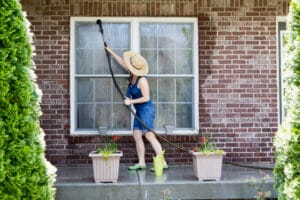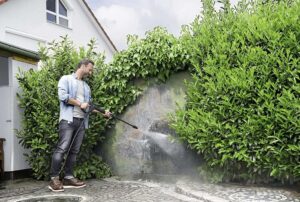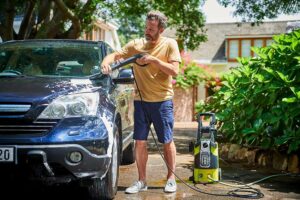Last Updated on January 10, 2023
A pressure washer is a valuable investment if you want an easy way to clean pavement and other areas around your home. The right power washer will quickly and conveniently eliminate unwanted grime, dirt, and even extra moss or mould.
However, if you’re not careful, you could also accidentally damage your pavement and other belongings by using your pressure washer incorrectly. If you’ve been keen to learn how to use a pressure washer yourself, but you’re nervous about causing unnecessary damage, this article will help.
How Do Pressure Washers Work?
To run this powerful cleaner safely, you have to understand how pressure washing works. Pressure washers are machines that use motors powered by either electricity or gas to drive the performance of a pump. Unlike your standard low-pressure water supply from a garden hose, a pressure washer can increase the impact of the water, to remove dirt faster.
 Pressure washers come in a variety of sizes and styles, offering a great way to clean the areas around your home. However, the amount of water per minute you can produce will depend on various factors including your washer’s pounds per square inch (PSI).
Pressure washers come in a variety of sizes and styles, offering a great way to clean the areas around your home. However, the amount of water per minute you can produce will depend on various factors including your washer’s pounds per square inch (PSI).
Typically, electric pressure washers can sit at the lower end of the pressure setting range – at an average of up to around 1500 PSI. On the other hand, gas-powered pressure washers can achieve a much more significant spray, ranging up to 3000 PSI. Here are some terms you’ll need to know when learning about pressure washers:
• Pounds per Square Inch (PSI) – the amount of pressure produced by the machine per square inch. The higher your PSI, the greater the power.
• Gallons per Minute (GPM) – this refers to the flow of the water and how quickly it moves. A high GPM indicates that your pressure washer isn’t very efficient.
• Cleaning Units (CU) – this basically refers to the number you get when you multiply the GPM by the PSI rating. The higher your CU, the better.
Gas pressure washers are often more appealing for commercial use, while electric alternatives are affordable and more energy-efficient for everyday consumers.
When Should You Be Using Your Pressure Washer?
While pressure washers are fantastic for a lot of reasons, they’re also not right for every occasion. A pressure washer used at the wrong time and on a higher-pressure setting could harm the coating of your car, or cause problems with your stonework.
 Ideally, you’ll have to use your washer whenever you want to get rid of dirt or caked-on grease that’s hard to remove with your standard water inlet and garden hose. You should never pressure-wash anything that’s living, including your plants. Make sure that you use plastic coverings and other protection to avoid letting the high-pressure water interact with them.
Ideally, you’ll have to use your washer whenever you want to get rid of dirt or caked-on grease that’s hard to remove with your standard water inlet and garden hose. You should never pressure-wash anything that’s living, including your plants. Make sure that you use plastic coverings and other protection to avoid letting the high-pressure water interact with them.
Gas pressure washers are often more appealing for commercial use, while electric alternatives are affordable and more energy-efficient for everyday consumers. Since pressure washers are intended for tougher and larger jobs most of the time, it doesn’t make sense to use them often on smaller spaces.
Keep in mind that the strategy you use with your pressure washer cleaner may change depending on whether you have a gas-powered or electric machine. Electric washers shouldn’t use extension cords, because there’s a risk of electrocution if the cord isn’t properly grounded. You should always consult a manual before using an extension cord.
If you’re trying some gas-powered pressure washing, make sure that you avoid using the product indoors or in a closed space. When you turn on these devices, you’ll need adequate ventilation for the exhaust. Otherwise, this could cause problems with your health if you’re not careful. Make sure that the engine can breathe properly and try to avoid letting it overheat. Allow the engine to cool down before you put the machine away.
Tips to Use a Power Washer Safely
You can use your pressure washer to clean everything from the concrete in your garden to the wheels of your car. It’s an excellent way to make your patio look as good as new without using too much effort on scrubbing. However, a pressure washer can be dangerous, too. High-pressure water can mar your wall paints, gouge holes in your bricks, and deplete your water supply very quickly.
Before you start using your power washers, make sure you consider these tips carefully:
Read the Manual
Your gas-powered or electric power washer will come with instructions on how to safely remove dirt and debris. The instructions will give you advice on what kind of water pressure and cleaning power to use for stubborn dirt, and whether you should try any cleaning products or soaps.
Prep Your Surroundings
Before you begin to wash the car or the garden walls, make sure that you cover anything you don’t want to get damaged by the machine. This might include freshly painted patio surfaces, plants, and hoses.
Wear the Right Protective Gear
Before you use any piece of equipment, you should ensure that you’re wearing the right gear. Don’t turn on the spray before you’ve applied work gloves and safety goggles. You should also have enclosed shoes on to protect your feet, and ear protection if you’re going to be washing with a gas power device.
Avoid the High-Pressure Nozzle
 The nozzle or spray tip with the most power is the red one. These high-pressure tips can shoot a stream of dangerously powerful water onto a surface that can damage your equipment and even yourself. It’s unlikely that you’ll ever have to clean a surface with that kind of spray so it may be safer to discard it entirely.
The nozzle or spray tip with the most power is the red one. These high-pressure tips can shoot a stream of dangerously powerful water onto a surface that can damage your equipment and even yourself. It’s unlikely that you’ll ever have to clean a surface with that kind of spray so it may be safer to discard it entirely.
Learn How to Use the Wand
A pressure wash machine will come with a wand attached to the pump to help direct the stream of water. Keep your hands away from the device’s spray. Also, make sure that you never direct the spray towards anyone else, including your pets.
Don’t Use a Ladder
You’ll struggle to run a power washer engine and clean all your surfaces while balancing on a ladder at the same time. The right machine can kick out a lot of force, and the last thing you want is for your cleaner to throw you off the ladder, particularly if you’re high up.
Tips for a Better Clean
Taking the time to track down the best power washer or pressure cleaner will improve your chances of getting great results. However, it’s also worth making a plan for your power washing, too. For instance, you might want to look into whether your engine will accept things like power washer detergent to help with removing stubborn stains.
Some of the lower pressure pump alternatives can come with the option to use detergents if you’re struggling to remove difficult patches of dirt and grime. However, using the solution on the wrong things can lead to harm.
 To get the most benefit out of your power washers, be sure that you tackle a small amount of space at a time. Using a pressure washer is easier when you’re focusing on smaller spots. You should also ensure that all of the things that could be harmed by your washer are out of the way before you begin, including any garden hose or piping.
To get the most benefit out of your power washers, be sure that you tackle a small amount of space at a time. Using a pressure washer is easier when you’re focusing on smaller spots. You should also ensure that all of the things that could be harmed by your washer are out of the way before you begin, including any garden hose or piping.
Lay tarps around the perimeter of the house to protect your plants and collect anything that might be removed while you’re cleaning. It’s also worth being careful that you don’t expose sensitive materials to too much water. Drenching wood and other porous materials with too much water can increase your chances of rot and mould.
Remember that you should never spray your pressure washer directly at any material that might break, such as glass and ceramics.
Tips on How to Choose the Right Spray
Some models are designed to deliver more power than others. However, there are a lot of pressure nozzle tips out there that you can use to focus the flow of water in the direction that’s best for you. Your nozzles are the most important accessory when figuring out how much power you need for specific jobs. Most of the time, you can check the power of the nozzle by the colour:
Red (0-degree)
This is the toughest tip for removing stains and debris, but it’s also the most dangerous. You should focus on small areas of concrete and metal with this nozzle, that’s if it’s ever necessary for you to use it.
Yellow (15 -degree)
With a yellow nozzle, you can conduct some surface prepping to remove excess dirt, paint, and mildew. You can also remove tough grime from a distance.
Green (25-degree)
Commonly used around the home, the green nozzle is good for boats, cars, lawn furniture, decks, and driveways.
White (40-degree)
This gentler, wider spray handles fragile surfaces like blinds, windows, and even some of your plant pots.
Black (Low Pressure)
This is the nozzle with the lowest pressure that’s ideal for applying detergents and soaps.
Turbo
This nozzle can come with the power cleaner wand that you get as standard. They produce a gentle pressure with a rotation option and cut cleaning time in half for caked-on grime and dirt.
Pressure Washing FAQ
A pressure washer is an excellent cleaning device that can help you to get rid of stains on virtually any surface. The right spray and nozzle type will help you to use less water when you’re getting rid of stains with your chosen wand, and you can even experiment with detergent to make light work of smaller jobs.
However, learning how to use a pressure washer correctly can be daunting so you may have a few questions about how everything should work. Here are some of the questions we find people asking most often when using these machines.
Q: How long can you run a pressure washer?
The answer to how long you can use your pressure washer will depend on a few things. Reading the instructions that come with the pump will help you to keep a general run-time in mind. If you have a gas-powered model, you might not be able to use your unit for as long because you might run out of fuel. One point to consider also is that the wand nozzle you choose may affect your run time.
Q: Is a pressure washer the same as a power washer?
 Although a pressure washer and power washer pump can do similar work, they are a little different. Pressure washer machines can clean your decking with a wand at the temperature that you fill the water tank with. Alternatively, a power washer comes with additional power that can help to heat the water and detergent before it comes out of the wand. There’s no one-size-fits-all when it comes to choosing the right product.
Although a pressure washer and power washer pump can do similar work, they are a little different. Pressure washer machines can clean your decking with a wand at the temperature that you fill the water tank with. Alternatively, a power washer comes with additional power that can help to heat the water and detergent before it comes out of the wand. There’s no one-size-fits-all when it comes to choosing the right product.
Q: Is a pressure washer dangerous?
Used correctly, a pressure washer can be a great way to clean your car and various other fragile items. However, if you use the wrong tip on your wand, then you could pump too much water at a high pressure from the start, which could lead to potential issues. The best way to protect yourself is to find the instructions and learn how to operate your washer effectively first. Learn how to use each hose and spray level accordingly, and you could even use less water when cleaning.
Even if you’re using low-pressure tip options and detergent, make sure you read any manuals and look online for videos you can find before you start cleaning.
Q: What do you put in a pressure washer?
Most of the time, you will be able to clean a wide range of surfaces with water alone, and the right kind of hose. However, depending on the tip you’re using and the kind of washing you do, a soap might be helpful. If you’re going to wash a car, for instance, you can use a special car detergent to get a better finish with a lower pressure tip.
Using a detergent before you start cleaning your car could be a good way to keep from using high-pressure tip options that might damage the surface.
View this post on Instagram
Q: Do you need to do maintenance on your pressure washer?
A power washer requires care and attention to operate at its best. Each time you use this cleaning product with a decent amount of water, it’s worth making sure that the hose and the cleaning system is still in good condition. Check that you’re using the right tip for each surface and task, as this will reduce the excess energy you need to use. You can also consider using a pressure washer detergent to help with cleaning.
Follow the guidelines provided by the manufacturer before you start calling the support team for help. You can keep your device in better condition if you avoid using the pump for too long, stay away from dangerous detergent options, and always keep your pressure washer inside after using it.
Final Thoughts
So there you have it! Learning how to use a pressure washer really counts if you want to make the most out of these cleaners. With the right tools and information, using one can be safe and easy to do. Follow our few simple tips and guidelines and you will have it up and running in no time. Let us know how you get on.
Rebekah is a writer who loves to explore new products and find hacks that make life easier. She has a knack for all things home improvement, health and fitness. So you’ll often find her on Pinterest or browsing Houzz for ideas.
She’s always looking for the next thing to fix up around the house or what gadget might be just right for her lifestyle. Rebekah enjoys exploring new recipes, taking care of her family, and making sure she stays healthy with regular workouts at the gym.

